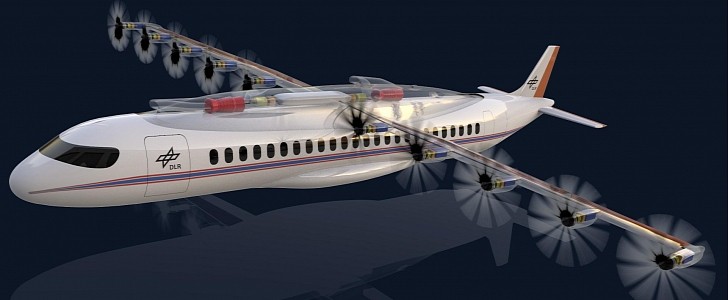The German Aerospace Center (DLR) is working on a future regional aircraft powered by a hybrid-electric system, together with other big names in the industry, including Airbus and Rolls-Royce. The project conducted a comprehensive study of the aircraft’s design, and a prototype has recently been tested at DLR.
One of the reasons why aviation is considered one of the most difficult sectors to decarbonize is that a lot of research and extensive testing are required before bringing major changes to aircraft propulsion. While some startups in the industry claim that their hybrid solutions can be fitted on existing aircraft without any major modifications, DLR investigated the design changes that go hand in hand with a hybrid-electric aircraft that can carry 100 passengers.
This study is part of SynergIE, a program that’s funded by the German Federal Ministry for Economic Affairs and Energy, where DLR collaborates with Airbus, Rolls-Royce, and Bauhaus Luftfahrt, with the objective of cutting emissions and reducing noise pollution levels for regional flights.
During the research, team members found that one of the main advantages of electric propulsion is a more efficient aerodynamic design. Regional aircraft usually have oversized wings, for better performance during take-off and landing, but these also end up consuming a lot of energy while cruising. On the other hand, as Martin Hepperle from the DLR Institute of Aerodynamics and Flow Technology explains, electric aircraft can have smaller and lighter wings, because the thrust is distributed over multiple propellers.
After studying the advantages and disadvantages of various design concepts, the team opted for a model with 10 electric motors along the edge of the wing, and turbogenerators in the fuselage. This design helps reduce energy consumption by 10%, compensating for the increased weight of the hybrid-electric propulsion system. Hepperle added that this design also incorporates a smaller and lighter vertical stabilizer and that it’s even capable of compensating for the failure of two motors, which makes it more reliable.
A prototype with these design modifications was virtually tested in the DLR Air Vehicle Simulator (AVES), showing that there are still issues that need to be tackled, particularly related to landing efficiency. But DLR and the other members in the project will continue to improve this design concept until a final hybrid-electric 100-seater will be ready to change regional aviation.
This study is part of SynergIE, a program that’s funded by the German Federal Ministry for Economic Affairs and Energy, where DLR collaborates with Airbus, Rolls-Royce, and Bauhaus Luftfahrt, with the objective of cutting emissions and reducing noise pollution levels for regional flights.
During the research, team members found that one of the main advantages of electric propulsion is a more efficient aerodynamic design. Regional aircraft usually have oversized wings, for better performance during take-off and landing, but these also end up consuming a lot of energy while cruising. On the other hand, as Martin Hepperle from the DLR Institute of Aerodynamics and Flow Technology explains, electric aircraft can have smaller and lighter wings, because the thrust is distributed over multiple propellers.
After studying the advantages and disadvantages of various design concepts, the team opted for a model with 10 electric motors along the edge of the wing, and turbogenerators in the fuselage. This design helps reduce energy consumption by 10%, compensating for the increased weight of the hybrid-electric propulsion system. Hepperle added that this design also incorporates a smaller and lighter vertical stabilizer and that it’s even capable of compensating for the failure of two motors, which makes it more reliable.
A prototype with these design modifications was virtually tested in the DLR Air Vehicle Simulator (AVES), showing that there are still issues that need to be tackled, particularly related to landing efficiency. But DLR and the other members in the project will continue to improve this design concept until a final hybrid-electric 100-seater will be ready to change regional aviation.






